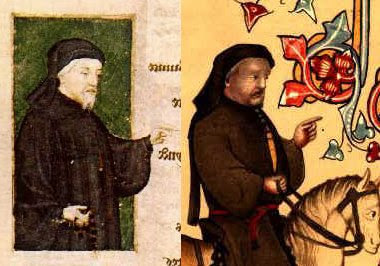
Those of you who obsessively follow all the links I post in my blog’s sidebar are by now longtime fans of the site Photoshop Disasters, a blog dedicated to tracking down and mocking egregious photoshop-based fail. But for those of you who ignore my erudite elseblog recommendations, it’s Photoshop Disasters’ job to catch people in the act of doing things like covering up for Christopher Lambert’s tragic inability to grasp solid objects by using Photoshop to paste a sword on top of his hand for the DVD case art of that not-as-horrible-as-the-other-sequels-but-still-pretty-horrible Highlander sequel of a few years back. Like so:

It might come as some surprise to fans of Photoshop Disasters to learn that people have been failing at Photoshop since long before Photoshop was invented. Take the image at the top of this blog post. That’s the famous portrait of Chaucer from the Ellesmere manuscript of the Canterbury Tales. Now take a closer look, in particular, at the proportions of torso to horse. Here’s a handy ghost-torso to make it easier:

The illuminator of the Ellesmere manuscript inadvertently gives the impression that Chaucer was either 1) a freakish giant with a torso nearly as tall as a horse, or 2) a midget with stumpy legs that rode around on similarly stumpy ponies.*
Now, given that medieval artists are not known for their skill at perspective and proportion, you might be tempted to think that this is just a bad artist who doesn’t know how big horses are.*** But, actually, the problem is that the artist doing a bad copy and paste job from another famous image found in Thomas Hoccleve’s Regiment of Princes:

Hoccleve was a poet who wrote in the wake of Chaucer and who styled himself as one of Chaucer’s students and poetic successors. Whether he actually knew Chaucer or not is a subject of some debate, but nonetheless Hoccleve claims to have known Chaucer well enough that, writing several years after Chaucer’s death, he was starting to worry that people would forget what Chaucer looked like in life. To remedy this, he commissioned a portrait of his “worthy master” and had it placed in the margin of a manuscript of his poem. When the Ellesmere illuminator went looking for visual references for his portrait of Chaucer, he seems to have found Hoccleve’s version and decided to base his image on it. Here are the two images, side by side, with Hoccleve’s portrait mirror-imaged:

The problem with the Ellesmere illuminator’s plans is clearly that the original image was a 3/4 portrait, and at some point in the planning of the Ellesmere manuscript it had been decided that all the pilgrims, Chaucer included, would be depicted on horseback in the margin of their respective tales.**** So it fell to the illuminator to sketch a horse in underneath the famous picture. The result is poor compositing, fifteenth-century style. Though, to give credit where it’s due, turning the rosary in the Hoccleve Chaucer’s portrait into the reins of the horse in the Ellesmere is pretty inspired.
Now, one corollary of this botched medieval photoshopping is that the Ellesmere manuscript has got to be later than Hoccleve’s Regiment of Princes (circa 1411 or so, last I heard). So those of you trying to push Ellesmere back to 1405 or so need to lay off. Yes, it’s a pretty manuscript, but pretty does not authority make. Though, I suppose if you wanted to, you could argue that Hoccleve’s artist swiped from Ellesmere (especially since lots of people don’t believe Hoccleve knew Chaucer), but if that is the case then we really have to wonder why the Ellesmere artist went with Chaucer the overweight stumpy midget in the first place, and why Hoccleve’s artist knew enough to fix it.*****
—
*Paul Bettany, who played Chaucer in the tragically under-appreciated A Knight’s Tale, seems to subscribe to the second theory. In preparation for the role he was given a selection of Chaucer paraphernalia that included the Ellesmere portrait, causing him to remark on the commentary track to the effect that “Chaucer was apparently some sort of overweight dwarf. I decided to go another way with the character, but I think you can see the inner dwarf shining through.”**
**I’ll get the exact quote later.
***And it must be noted that several of the other Ellesmere portraits have too-large people atop them, but none so disproportionate as Chaucer.
****This, in itself, is an odd choice, since not all the pilgrims appear to ride horses in General Prologue. It would certainly be weird for some of the poorer pilgrims to be mounted.
*****One final note. For the record, this whole composting thing is not my personal discovery or anything. I first learned of it in a class taught by Derek Pearsall. That it’s essentially a case of bad photoshop, that’s my only contribution.